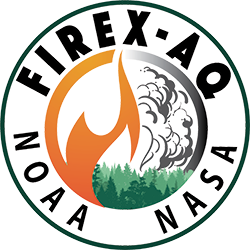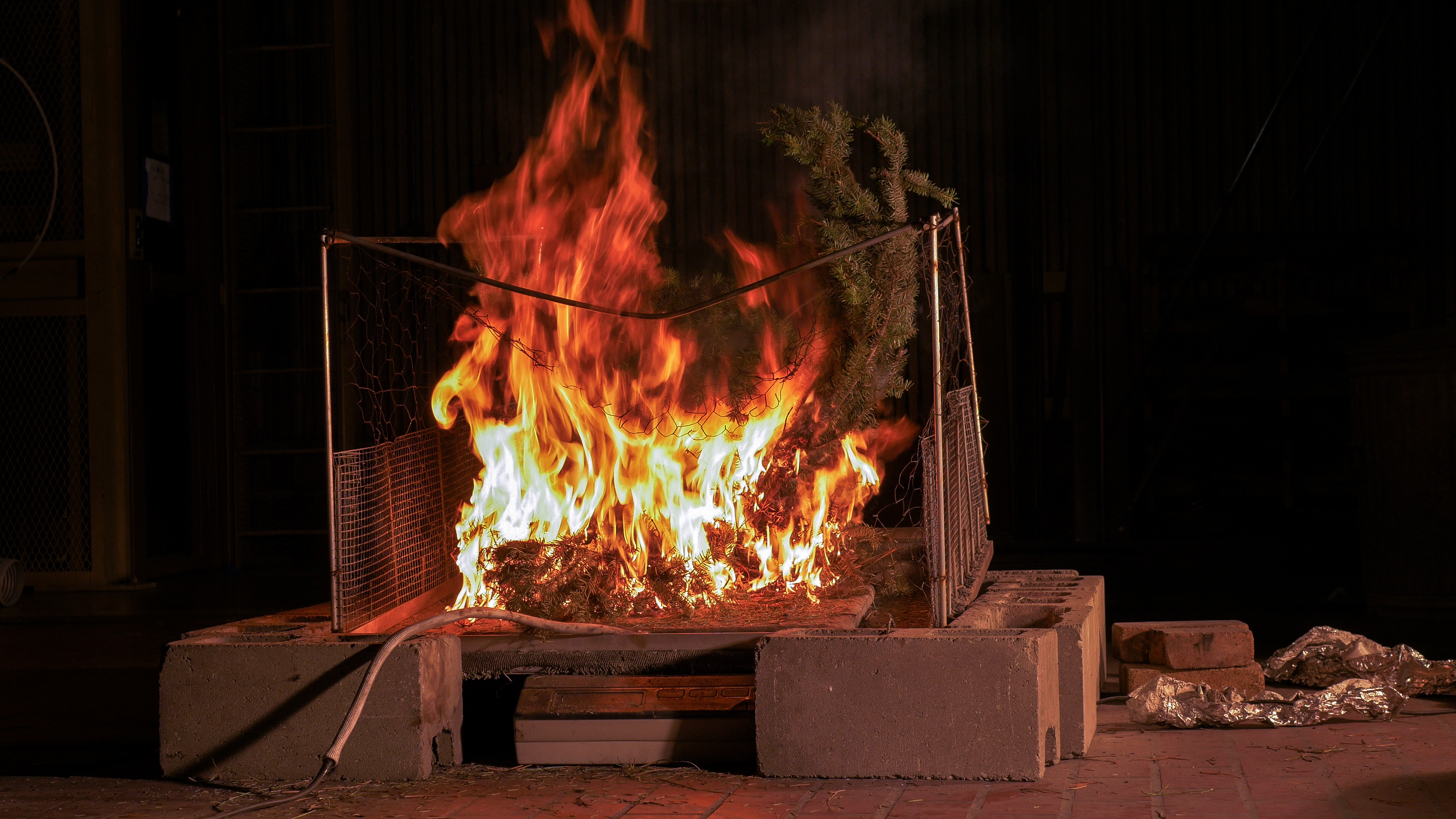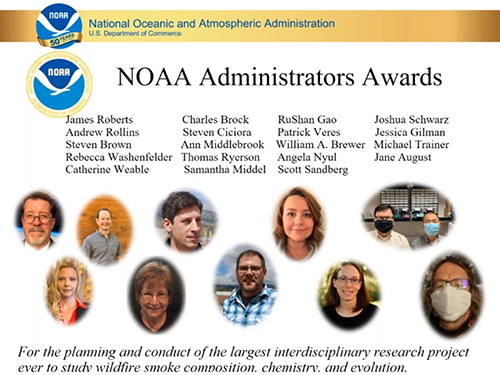A .gov website belongs to an official government organization in the United States.
A lock () or https:// means you've safely connected to the .gov website. Share sensitive information only on official, secure websites.
29 October 2020

The Fire Influence on Regional to Global Environments and Air Quality (FIREX-AQ) campaign was a joint venture led by NOAA and NASA to provide comprehensive observations to investigate the impact on air quality and climate from wildfires and agricultural fires across the continental United States.
A team from CSL receives the NOAA Administrator's Award "for the planning and conduct of the largest interdisciplinary research project ever to study wildfire smoke composition, chemistry, and evolution." Jim Roberts, Chuck Brock, Ru-Shan Gao, Joshua (Shuka) Schwarz, Drew Rollins, Steve Ciciora, Patrick Veres, Jessica Gilman, Steve Brown, Ann Middlebrook, Alan Brewer, Scott Sandberg, Michael Trainer, Rebecca Washenfelder, Tom Ryerson, Angie Nyul, Jane August, Cathy Weable, and Samantha Middel are all recognized. Joint institute staff Aaron Lamplugh, Adam Ahern, Ale Franchin, Ann Weickmann, Brian McDonald, Carrie Womack, Carsten Warneke, Cathy Rasco, Christina Williamson, Frank Erdesz, Georgios Gkatzelis, Ilann Bourgeois, Andy Neuman, Jeff Peischl, Joe Katich, Karl Froyd, Ken Aikin, Kyra Slovacek, Laurel Watts, Macy Morgan, Matt Coggon, Max Holloway, Megan Bela, Mike Robinson, Mike Zucker, Nick Wagner, Pam Rickly, Paul Schroeder, Rick Tisinai, Stuart McKeen, Troy Thornberry, and Zachary Decker receive a Cooperative Institute for Research in Environmental Science (CIRES) Administrator's Award for this achievement.
The FIREX-AQ project was unlike any other atmospheric chemistry project undertaken by CSL in that it required substantial cross-discipline and cross-organization coordination and cooperation. The project involved several stages; the first stage involved studying the results of previous research on fires, learning from fire professionals what the outstanding research questions were, and developing a suite of analytical methods and experiments to address those unknowns. In the process of these initial planning stages, CSL acquired the support and collaboration of a large number of key agencies, university research groups, and private research corporations. There were eight primary mission partners, eight partnering agencies, 35 measurement groups, and 17 forecast and model groups. The number and variety of collaborators attests to the deep-seated interest in the US in wildfire research and impacts.

In the second stage, FIREX FireLab 2016, fuels that are characteristically consumed in western North American wildfires were burned under controlled laboratory conditions. This effort took place at the USDA Forest Service Fire Research Laboratory in Missoula, MT and involved nearly 80 researchers who operated 40 instruments that sampled the chemistry and composition of the resulting smoke plumes. CSL scientists operated key instruments (Brock, Brown, Gilman, Middlebrook, Roberts, Schwarz, Washenfelder). This 6-week project in 2016 involving 107 controlled burns was designed and led by CSL (Roberts). The scientific results, such as the systematic dependence of emissions on fire temperatures, provided key, novel information for interpreting the later measurements made in wildland smoke plumes.
In the third stage, a combination of ground-based and airborne platforms, mobile laboratories and satellite instruments was used to sample the physical and chemical characteristics of wildfires in the forested areas of the western US and of agricultural fires in the central and southeast US in the summer of 2019. The airborne platforms included two NOAA Twin Otter aircraft and the NASA DC-8, the world's largest airborne laboratory. CSL scientists served as mission scientists for the three aircraft. CSL scientists also served as the principal investigators of more than 15 instruments on the airborne payloads sampling a wide variety of gases and aerosols in the targeted smoke plumes (Brewer, Sandberg, Brock, Brown, Ciciora, Gao, Gilman, Middlebrook, Rollins, Ryerson, Schwarz, Trainer, Veres, Washenfelder). The plumes from more than 80 individual fires were sampled over the course of the 8-week field deployment.
Operating the joint NOAA and NASA aircraft presented distinct challenges to the mission scientists leading both groups as well as unique opportunities. Both groups were responsible for respective payload designs and logistics, fire identification and associated overflight patterns and protocols for the in situ airborne observations, and coordination with satellite instruments passing over the fires. The two NOAA Twin Otter aircraft (led by Brewer and Brown) were deployed to obtain measurements of meteorological and chemical parameters closer to the fires than possible with the NASA DC-8 (led by Schwarz) and close to the ground on night flights. These efforts required considerable creativity, flexibility, and diligence since the aircraft had limited range and fire occurrence and spreading conditions changed on an hourly basis. Instrument investigators worked tirelessly to prepare instruments for flight, operate them in flight, and evaluate data quality for each flight and conduct a preliminary analysis of the data in context with the sampled fire event.

The logistical supporters of FIREX FireLab and FIREX-AQ had to overcome considerable challenges in terms of arranging travel for both aircraft deployment teams, acquisition of needed equipment and supplies, shipping large quantities of instrument support equipment to test flight and deployment locations, establishing and maintaining accounting records to capture and report on actual costs, and ensuring funds availability throughout the entire mission. The CSL administrative and budget personnel (August, Weable, Nyul, and Middel) exceeded expectations based on the smooth and nearly flawless execution of the logistical activities of coordinating and moving the people, funds, materials, and equipment needed to support the mission.
In addition, Joshua (Shuka) Schwarz, Jim Roberts, Jessica Gilman, Steve Brown, Rebecca Washenfelder, Ann Middlebrook, Alan Brewer, Kenneth Mooney (NOAA CPO) and Mitch Goldberg (NOAA NESDIS) receive a NOAA Bronze Medal, and joint institute researchers Aaron Lamplugh, Adam Ahern, Ale Franchin, Ann Weickmann, Carrie Womack, Carsten Warneke, Frank Erdesz, Georgios Gkatzelis, Ilann Bourgeois, Andy Neuman, Jeff Peischl, Joe Katich, Ken Aikin, Macy Morgan, Matt Coggon, Mike Robinson, Mike Zucker, Nick Wagner, Pam Rickly, Zachary Decker, and Ravan Ahmadov (GSL), along with colleagues from the University of Colorado Department of Chemistry, receive the Cooperative Institute for Research in Environmental Science (CIRES) Bronze Medal "for outstanding execution of the FIREX-AQ mission, a joint venture with NASA to improve understanding of air quality and climate impacts of fires."